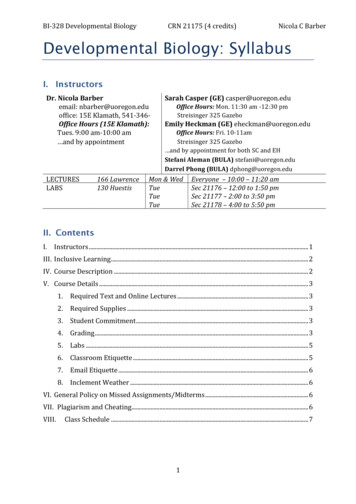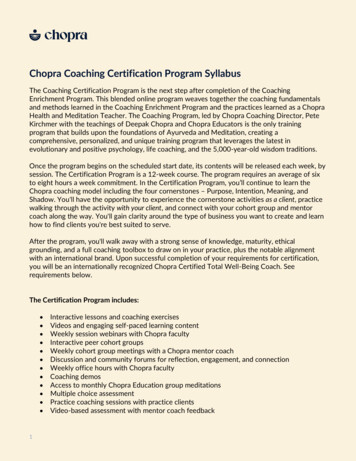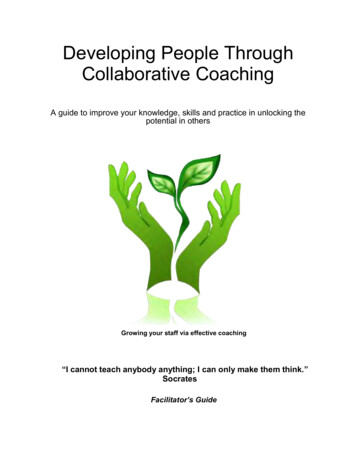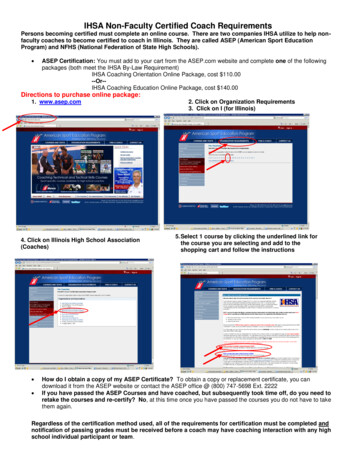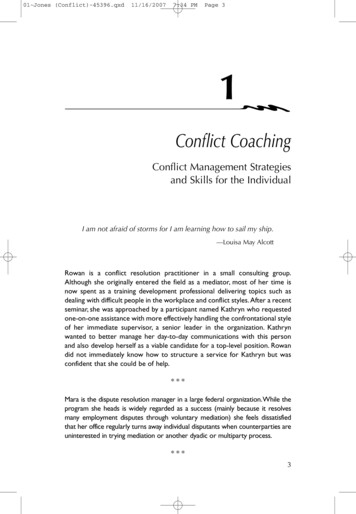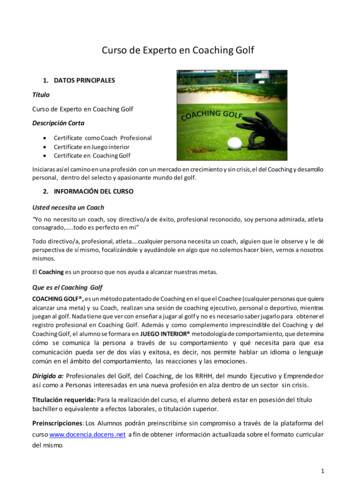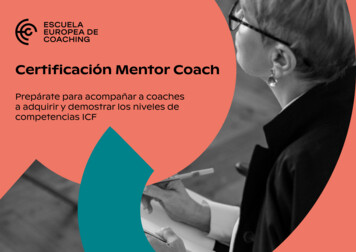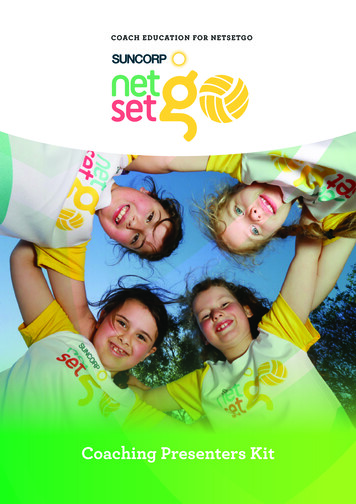
Transcription
COACHING MANUALDuring home visits practitioners can assist caregivers in learning ways to support theirchild by coaching the caregivers in how to use appropriate strategies. This sectioncontains a description of the many SELECT resources linked to the coaching process, aswell as a step-by-step guide of the coaching process.Resources for Addressing this Benchmark: There are several resourcesfrom the SEAM and the SELECT curriculum that can be used to supportpractitioners as they work with families on encouraging social-emotionalskills with their child. Use the resources listed below to help prepare forthe coaching process and provide guidance to families throughout thecoaching process.Preparation for Coaching: These resources should be used before you start thecoaching process. They can be used to gather specific information about the family’sconcerns, caregiver skills and caregiver stressors. In addition, the BenchmarkIntroduction for caregivers helps introduce the benchmark to the family. SEAM Family Profile: The Family Profile can be used to help you gatherinformation on how the caregiver interacts with their child. It can assistpractitioners in pinpointing areas where the caregiver would like support infostering their child’s social-emotional development. In addition, if the caregiverindicates that they need other types of assistance (e.g., housing, counseling),practitioners can first address these concerns before focusing on the coachingprocess. SELECT Interview: The SELECT Interview can be used when you first startestablishing a relationship with the family. The interview can aid in gatheringadditional information about the caregiver’s concerns related to their child’ssocial-emotional development. It helps identify activities and routines where thechild might need additional support. Benchmark Introduction: The Benchmark Introduction is a good resource to useonce the caregiver has decided that they want to focus on a specific benchmark. Itcan be used to introduce families to the concept and skills involved in thebenchmark. It also provides some general tips and specific strategies forencouraging benchmark skills. The Benchmark Introduction should be introducedduring the home visit prior to starting the coaching process.During Coaching: The following SELECT components should be used during thecoaching process. They assist practitioners in following the coaching process andteaching caregivers how to use new strategies. Some can be left as a resource forcaregivers to use between home visits.Social-Emotional Assessment/Evaluation Measure Curriculum (SEAM PLUS) Research Edition. Copyright 2020Paul H. Brookes Publishing Co., Inc. All rights reserved.Project SELECT: Supported by Grant R324A150145, U.S. DOE Institute of Education Sciences at the University of Oregon.
Coaching Checklist: Practitioners can use the Coaching Checklist during homevisits to help them implement the coaching process correctly with families. It is achecklist that serves as a reminder of all of the different steps. Try, Watch & Wait, Respond Table: The Try, Watch & Wait, Respond Table isused to introduce the teaching sequence to caregivers during the coaching process.The table is formatted to show the teaching sequence (1. Try a strategy, 2. Watchand Wait for child’s response, 3. Respond to child).1. Fill in the “Target Benchmark Skill” with the individualized SEAMBenchmark skill you are working on with the child.2. Fill in the first column of the table (“Try a Strategy”) with the SELECTstrategy you and the family have chosen to use for supporting the child inworking on the target skill.3. Fill in the “Watch & Wait” column with the possible child responses.o Next to the happy face, describe the behavior you want the child todo (refer to the target benchmark skill).o Next to the unhappy face write in other possible ways the childmight respond (non-target behaviors).4. Fill in the “Respond” column with possible ways the caregiver canrespond to their child.o Next to the happy face, write in what the caregiver should do whenthe child performs the target behavior.o Next to the unhappy face, write in ideas for providing additionalsupport if the child doesn’t respond by doing the target skill. Home Visit Notes: Practitioners can use the Home Visit notes to documentstrategies tried during the home visit and emphasize what the caregiver did well.The notes provide a space to record the specific strategies the family wants tofocus on, as well as a checklist to identify the specific daily routines in which theywill try out the strategies. Family Reflection Form: Caregivers can use the Family Reflection Form to trackand monitor how it went using the strategy with the child during the week. Theform can be completed by caregivers between visits or it can be completedtogether with the provider using an interview format at the following home visit. SELECT Activities (optional): Each benchmark has a set of activities thatcorrespond with the benchmark skills. The activities provide specific examples ofhow caregivers can incorporate strategies to encourage social-emotional skillsthroughout their daily routines. Activities are an optional component and can beleft with families as a support to use in between home visits to help withgeneralization. Choose routines that match with the family’s schedule and needs.*Note: The Home Visit Note and Family Reflection Form can be photocopied back toback. This allows the family to keep the information together and have less paperworkSocial-Emotional Assessment/Evaluation Measure Curriculum (SEAM PLUS) Research Edition. Copyright2 2020Paul H. Brookes Publishing Co., Inc. All rights reserved.Project SELECT: Supported by Grant R324A150145, U.S. DOE Institute of Education Sciences at the University of Oregon.
Coaching ProcessThe following coaching process has been developed from evidence-based practices foradult learning. Throughout the coaching sequence practitioners provide guidance andsupport to caregivers as they learn new strategies for working with their child. Thecoaching process incorporates modeling and guided practice, which have been shown tobe effective in helping adults learn and implement new practices. Practitioners shoulduse the coaching process after they have already established a relationship with thefamily and determined the target areas (e.g. SEAM Benchmark skills) that caregiverswant to focus on during coaching.Preparation for CoachingOn the home visit prior to beginning the coaching process help prepare caregivers forcoaching by introducing them to the benchmark you will be focusing on with their child.Benchmark Introduction: Provide caregivers with the appropriate BenchmarkIntroduction so that they can get an overview of the benchmarks skills and strategies used toaddress the skills. Discuss the importance of the benchmark skill you will be focusing onwith them. Come up with a caregiver-friendly way of describing it.For example:“When we talk about cooperation it means that you and Maria are working togetherso that routines like meal time or dressing go smoothly.” Briefly review the Benchmark Introduction. Let parents know it will give them somemore information about the benchmark skills, general tips (Keep in Mind section), somestrategies they can use to work with their child on the skills during daily routines, and anexample of the teaching sequence you will use during coaching. Encourage parents to look over the Benchmark Introduction before your next homevisit. Let them know that you will review it again the following week so they can askquestions and get further clarification if needed.Social-Emotional Assessment/Evaluation Measure Curriculum (SEAM PLUS) Research Edition. Copyright3 2020Paul H. Brookes Publishing Co., Inc. All rights reserved.Project SELECT: Supported by Grant R324A150145, U.S. DOE Institute of Education Sciences at the University of Oregon.
Coaching1. Check-In/Follow-Up from Last Visit: Start each home visit by checking in with thefamily to see how things are going.Oftentimes caregivers will have something they want to share with you or talk about at thebeginning of your visit. Check-in time can help caregivers feel more relaxed, focused, andready to work on strategies. It can also provide you with valuable information about what iscurrently happening between the caregiver and child. This information can help youunderstand where the family is in the intervention process and guide you in deciding nextsteps.Before you focus on planning an intervention take time to: positively greet the caregiver find out what has occurred since your last home visit.For example:“Hi Sofía, it is so good to see you and Maria. How have things been going since ourlast home visit?”Check-in time will look different based on where you are in the coaching process withfamilies. For initial coaching home visits check-in is a good time to remind caregiversabout the purpose of the home visit and see if they have any questions.For example:“Remember how we talked about focusing on Maria’s cooperation during routineslast week? Are you ready to try some strategies today?”Practitioners should have gone through the Benchmark Introduction on the home visit priorto beginning coaching. This gives the caregiver a chance to read about the skills, get someideas about strategies, and think about questions they might have. Remind caregivers aboutthe Benchmark Introduction and find out if they have any questions, or if it gave them anyideas.For example:“Did you have a chance to review the handout on cooperation that we went overlast week? Do you have any questions or thoughts about it?”For follow-up coaching home visits, it’s important to review plans from the previous homevisit (Try, Watch & Wait, Respond Table, Home Visit Notes) in order to remind caregiverswhat they have been working on and get their feedback on how it went. If caregivers havecollected data (Family Reflection Form) review the information with them. If they haven’tfilled out the form you can review and complete it with them.Social-Emotional Assessment/Evaluation Measure Curriculum (SEAM PLUS) Research Edition. Copyright4 2020Paul H. Brookes Publishing Co., Inc. All rights reserved.Project SELECT: Supported by Grant R324A150145, U.S. DOE Institute of Education Sciences at the University of Oregon.
For example:“Let’s look at the Home Visit Notes from last week to review our plan and see how itwent.”“Were you able to fill out the Family Reflection Form this week?”“Great, let’s look at it together and you can tell me how you think things went.”For follow-up coaching home visits remember to: Check in about priorities from your previous home visit Review Home Visit Notes from previous visit with caregivers Review any data the caregiver has collected (Family Reflection Form) or discussand complete together2. Plan: Once you have checked in with the family, and they are ready to focus on the targetskill, it’s time to partner with them to plan the intervention. Based on where you are in thecoaching process, this could be the first time you plan the intervention with the family or atime to revise plans based on how their child is responding to the intervention strategies.Work with caregivers to identify routines and activities in which they can work on theskill(s).If this is an initial coaching home visit you should have already prepared for the visit bycompleting the Reflection and Planning Worksheet. This worksheet helps you reflect on andsummarize family and child information and identify relevant information from theSELECT Provider Benchmark Guide. Use this information, as well as information obtainedfrom the family during Check-In, to help guide you in talking to the caregiver about theroutines and activities in which they would like to work within to encourage the target skill.Ask questions to clarify the caregiver’s priorities.For example:“You said earlier that she gets really upset during meal times, would you like to focuson that routine today?”Help caregiver select strategies that will work for them.After you have identified the routine or activity the caregiver wants to focus on, help themchoose a strategy they can use to work with their child on the targeted skill.Use information from the Reflection and Planning Worksheet to guide you in introducingone or two strategies to suggest to the family. Explain the strategy to the caregiver and askif they would like to try it.For example:“Based on what you shared with me about Maria, it seems like she really wants to beindependent. Maybe we could help her cooperate more during routines by giving her aSocial-Emotional Assessment/Evaluation Measure Curriculum (SEAM PLUS) Research Edition. Copyright5 2020Paul H. Brookes Publishing Co., Inc. All rights reserved.Project SELECT: Supported by Grant R324A150145, U.S. DOE Institute of Education Sciences at the University of Oregon.
special job to do for each routine.”“Giving her a special job allows Maria to have more of an active role duringmealtimes. It gives her a little control and makes it fun and interesting for her.”“How do you think she could help out during meal times? Could she help set the tableor bring you ingredients?”Things to remember during planning: Identify a routine activity Choose a strategy that fits into the routine activity Discuss and provide examples of how to use the strategy within the routine3. Guided Practice: Now that you have selected a strategy it is time to help the caregiverlearn how to use it. If this is an initial coaching home visit you will start by introducing thecaregiver to the teaching sequence (1. Try Strategy, 2. Wait for the child’s response, 3.Respond to child). If this is a follow-up coaching home visit you can remind them of theteaching sequence before you try out a new strategy or support them in continuing aprevious strategy. When explaining the teaching sequence to the caregiver, emphasize theback and forth interaction between them and their child.Prepare for implementation of the interventionBegin by looking at the environment to make sure it is ready to support caregiver-childinteractions. This includes assessing the physical space, the atmosphere (e.g., calm & quiet,or active and engaging), and any materials needed for the interaction (e.g., toys, diaper,food). In addition, the child should be in an appropriate state of alertness and have theirimmediate needs met (e.g., they are fed, have recently gone potty). If needed, suggestchanges that would support caregiver-child interactions.For example:“How about if we turn off the t.v. so that Maria isn’t distracted.”“Can we move her chair over here so she can reach the table more easily?”“Do you think she needs try using the potty before we begin?”Things to look for: Are there distractions that can be eliminated (e.g., turning off television)? Would a different position better support the child in the interaction? Are all the needed materials within reach?For example:“The big things to remember are to try the strategy, wait for Maria’s response, and thenrespond back to her”Review of the teaching sequence:Social-Emotional Assessment/Evaluation Measure Curriculum (SEAM PLUS) Research Edition. Copyright6 2020Paul H. Brookes Publishing Co., Inc. All rights reserved.Project SELECT: Supported by Grant R324A150145, U.S. DOE Institute of Education Sciences at the University of Oregon.
1) Try strategy and wait: Start the interaction by using the selected strategy.2) Watch for child’s response: Observe closely to see what child does when you usethe strategy.3) Respond to child: Respond immediately to the child’s reaction.o If the child responds positively, encourage them by providing positiveverbal or physical feedback.o If the child is upset, you can comfort them before trying the strategyagain.o If the child doesn’t respond, try something different.Encourage the Caregiver to Try the StrategyEncourage the caregiver to try the strategy they have chosen and support them throughoutthe teaching sequence (e.g., prompt them on what to do next, point out child’s response,etc.). The caregiver may prefer for you to model the teaching sequence first, before they tryit on their own. When modeling, make sure to talk about each step of the teaching sequenceas you use the strategy. Once you are done modeling the teaching sequence for thecaregiver, encourage them to try out the strategy themself.For example:“Why don’t you try it out with Maria. I’ll be here to support you.”“Do you feel more comfortable having me model the strategy before you try it?”“Remember to watch for her reaction and respond to her.”Things to remember during guided practice: Provide verbal support or modeling for caregiver Talk through the teaching sequence while practicing strategy4. Evaluate/Reflect: As the caregiver tries out the strategy observe closely and providefeedback on how they are doing (“You did a really nice job letting her choose how shewants to help. Look how excited she is to be helping.”) Additionally, after the caregiver hascompleted the teaching sequence, talk to them about how they felt the interaction went(“How do you think that went?”, “Did that feel comfortable for you?”) and providefeedback to support them. Use both supportive and constructive feedback with the caregiverduring and after the interaction (see examples below). Encourage the caregiver to try thestrategy again using your feedback, and continue to provide support.Supportive FeedbackLet the caregiver know what they are doing well. Point out the child’s positive responses totheir actions.Examples of supportive feedback:“You are using a really calm voice to reassure her.”Social-Emotional Assessment/Evaluation Measure Curriculum (SEAM PLUS) Research Edition. Copyright7 2020Paul H. Brookes Publishing Co., Inc. All rights reserved.Project SELECT: Supported by Grant R324A150145, U.S. DOE Institute of Education Sciences at the University of Oregon.
“Wow, look at how she started to help out as soon as you gave her a choice.”Use Constructive FeedbackIf necessary, help the caregiver modify what they are doing. Make sure to provide specificinformation.Examples of constructive feedback:“Did you notice how she seemed confused when you told her what to do? It might beeasier for her to understand if you gave her really short and simple directions. Forexample, you can tell her ‘Get spoon.’”The use of video can be helpful during this process. If the caregiver is comfortable havingtheir interaction videotaped, film their use of the teaching sequence and watch the videotogether afterwards so you can provide feedback. You can begin this interaction by askingthe caregiver to share their own observations (“How do you think that went?”, “What do youthink you did really well?”, “What part of the interaction would you like to change?”)Things to remember during evaluation/reflection: Start with supportive feedback Engage caregiver in problem solving Provide constructive feedback/ideas/suggestions as needed5. Review and Plan:After you have finished guiding the caregiver through the strategy check in with them abouthow they felt it went.For example:“Did that strategy seem comfortable for you to use?”“Does this seem like something you could do with her throughout the day?”This is a good time to address caregiver questions and reiterate some of your feedback.Home Visit NotesNext, help the caregiver come up with a plan for how they will use the strategy during theupcoming week. Use the Home Visit Notes to document the successes from the coachingsession (“Right On!”) and the strategy the caregiver has chosen to try (“Try These IdeasThis Week”). Brainstorm ways to incorporate the strategy into different times of the day(“During these Routines”) and mark the routines the caregiver has chosen.For example:“Let’s think about what other times of the day you might want to try doing this withyour child.”Social-Emotional Assessment/Evaluation Measure Curriculum (SEAM PLUS) Research Edition. Copyright8 2020Paul H. Brookes Publishing Co., Inc. All rights reserved.Project SELECT: Supported by Grant R324A150145, U.S. DOE Institute of Education Sciences at the University of Oregon.
After completing the top portion of the Home Visit Notes, review the “Keep in Mind”section to make sure the caregiver understands the teaching sequence.SELECT Activities (optional)Once you have completed and reviewed the Home Visit Notes, introduce a SELECTActivity for the benchmark to provide the caregiver with an additional tool they canreference as they try out strategies during the week. Review the teaching sequence table onthe back of the activity sheet, and write in a specific example using the strategy you and thecaregiver have practiced.Family Reflection FormBefore ending the home visit, share the Family Reflection Form with the caregiver. Letthem know this is a way to keep track of how the strategy goes during the week. They canuse it to gather information to share with you on the next home visit.Things to remember during reviewing and planning: Fill out Home Visit Notes Provide appropriate SELECT Activity Introduce the Family Reflection Form6. Closing the Home Visit: Before ending the home visit, check with caregiver to see if theyhave any final questions, thoughts or concerns. Next, schedule a follow-up visit. Let thecaregiver know how they can check in with you between visits if they need additionalsupport using the strategy.For example:“If you have any questions before our visit next week you can text me or call me at myoffice.”Social-Emotional Assessment/Evaluation Measure Curriculum (SEAM PLUS) Research Edition. Copyright9 2020Paul H. Brookes Publishing Co., Inc. All rights reserved.Project SELECT: Supported by Grant R324A150145, U.S. DOE Institute of Education Sciences at the University of Oregon.
COACHING MANUAL . During home visits practitioners can assist caregivers in learning ways to support their child by coaching the caregivers in how to use appropriate strategies. This section contains a description of the many SELECT resources linked to the coaching process, as well as a step-by-step guide of the coaching process.
